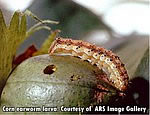Some Background
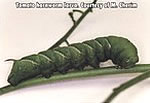
Caterpillars are, collectively, the larvae of moths and butterflies which are members of the order Lepidoptera. There are over 110,000 different species in this order, so nearly everyone has had, or will have, hands-on experiences with these guys — especially in outdoor crops and gardens, though some will invade greenhouses and other structures. Caterpillars are varied in name as some are called loopers or worms (i.e. cabbage loopers, hornworms and inchworms), some are actually soil pests such as cutworms, while other are called borers, but one fact remains that they are always moth or butterfly larvae and can be extremely destructive.
How They Become a Problem
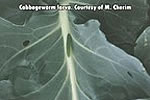
Infestations begin at different times of the year depending upon the life-cycle of the particular moth or butterfly in question. Many start their lives by hatching out of overwintered eggs late in the spring. Many will repeat this cycle of life many times over during the course of a growing season, while some have just one annual fling. Exponential growth, like that which is inevitable with aphids, should not be expected from caterpillars. They make up for their lack of reproductive capacity, though, by being ravenous feeders cutting gaping chunks and holes out of leaves or chopping into or tunneling through some fruits. Some species have been known to defoliate entire trees — even whole forests. Some are so gluttonous you actually hear them eating — which has been said of sizable tomato hornworms.
Many species of caterpillars begin the season as overwintered eggs. They hatch and mobilize to their feeding area, which at its furthest will be very close at hand. For example, Madame Butterfly lays her eggs at the base of a tree whose leaves will feed her next season’s offspring. If your timing is right, you may actually be a witness to an army of caterpillars climbing the trunk of a tree. Once the army of caterpillars reaches the tree’s leaves the feeding frenzy begins. Other species overwinter as pupae in a chrysalis or cocoon. They begin their annual ritual by emerging as a moth or butterfly in the spring, feeding on nectar while seeking a mate, then laying eggs directly onto the source of food: the leaves or fruit of the host plant.
A Serious Pest
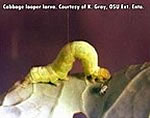
Caterpillars, with their cutting and chewing mouthparts, or mandibles, as was written before, can cause an exceptional amount of damage if not treated early-on or prevented. The key to coping with caterpillars does not necessarily lie in the thoroughness of your scouting but more in the knowledge of your foe and methodology and timing of your effort. Your area university’s cooperative extension office — since caterpillars are usually regional in distribution — will probably be able to provide information as to what species are known to be problematic in your area and at what time of year they are doing what they do. The extension agent may also be able to prescribe curative action, but may not be well-versed in the Green Methods, and thus may not be able to offer fully all the nontoxic ways to get the job done — and there are many.
ths and butterflies, as we’ve indicated, develop through a complete metamorphosis: egg, larva, pupa (chrysalis) and adult, which is usually done at a specific time of year based on species. (Unlike aphids which develop constantly throughout the season by way of an incomplete metamorphosis, molting through multiple immature nymphal stage before reaching, uninterrupted by pupation, their adulthood.) In light of this, scouting will be done differently at various times during the season depending on what species is being scouted. Moreover, if you see a caterpillar with “eggs” on its back, they’re not eggs as that’s not how these things work. More than likely the “eggs” you’re seeing are actually the pupae of parasitic wasps in cocoons of their own.
Some Advice
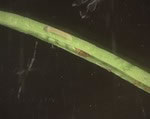
Caterpillars can be fast-feeding and merciless pests to have in your crop. The damage they can cause can be severe to the point of total crop loss through complete defoliation. Most medium-sized to large trees can handle two to three consecutive years of defoliation, but most of the crops produced by growers do not fall into this category. To most growers a large infestation can spell doom. Caterpillars are not usually very difficult to detect, but speed becomes a major issue as the irreversible damage they cause can form rapidly. During the appropriate times of year when known caterpillar species may be present, a daily performance of your scouting ritual may be prudent.
For The Scout
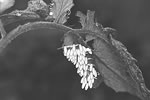
Assuming we’re writing about a species which overwinters as an egg, the scout should begin by looking for eggs in the immediate area. Following this he or she will look for the destructive larvae. The caterpillars will likely be apparent by either their presence (assuming they are not nocturnal), feeding damage or feces. The feces can be very large and detectable in vast quantities, especially if dealing with one of the bigger moth or butterfly species. Tomato hornworms are a good example of this: as larvae they can grow to three to four inches in length and their poop can be as large as quarter-inch chunks.
Some Solutions

The good news is caterpillars, regardless of size, color and area of activity — all of which is quite varied-are easily identifiable for what they are and can be simple to control if multiple and aggressive steps are taken quickly. Knowing the specific traits of the caterpillar species you expect to deal with is fundamental to your success-but it is not difficult. There are many tools available to you; all you have to do is to use them at the correct time and in the right way.


